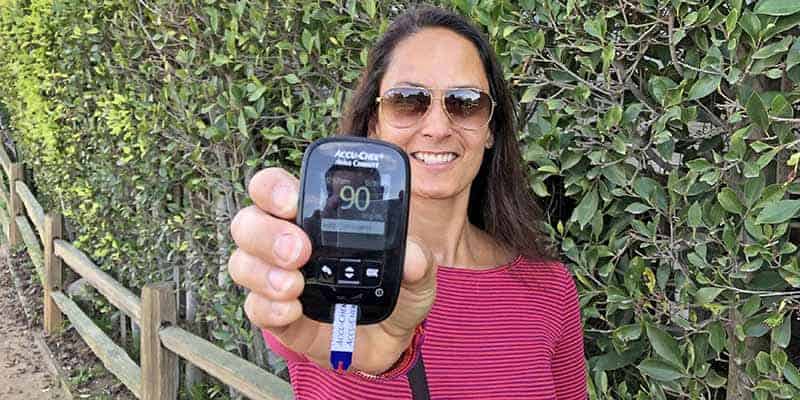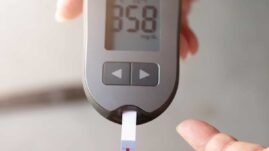Your blood glucose (sugar) levels are a critical part of your overall health and your body’s ability to function properly.
For those of us with diabetes, striving to achieve “normal” blood sugar levels is a constant, hour-by-hour pursuit. And it isn’t easy.
In this article, we’ll look at normal blood sugar levels and goal ranges for people without diabetes and recommended blood sugar goals for people with prediabetes, type 1 diabetes, and type 2 diabetes.

Table of Contents
- Normal blood sugar ranges in people without diabetes (chart)
- Recommended blood sugar ranges in people with diabetes (chart)
- How do you know what your blood glucose level is?
- Diagnosing prediabetes, type 1, and type 2 diabetes
- Your A1c and blood sugar goals
- Your blood sugar isn’t just because of what you eat
- Final thoughts: Still frustrated with your blood sugar and A1c results?
Normal blood sugar ranges in people without diabetes (chart)
For a person without any type of diabetes, blood sugar levels are generally between 70 to 99 mg/dL (3.9 to 5.5 mmol/L) fasting and under 140 mg/dL (7.8 mmol/L) after a meal.
Here are the normal blood sugar ranges for a person without diabetes according to the NIH:
| Fasting Blood Sugar (e.g., In the Morning Before Eating) | Less than 100 mg/dL (5.6 mmol/L) |
| 1 to 2 Hours After a Meal | Less than 140 mg/dL (7.8 mmol/L) |
| 2 to 3 Hours After a Meal | Less than 100 mg/dL (5.6 mmol/L) |
Recommended blood sugar ranges in people with diabetes (chart)
Here are the generally recommended blood sugar ranges for a person with diabetes according to the ADA:
| Fasting Blood Sugar (e.g., In the Morning Before Eating) | 80 to 130 mg/dL (4.4 to 7.2 mmol/L) |
| 1 to 2 Hours After a Meal | Less than 180 mg/dL (10.0 mmol/L) |
Learn more about fasting and after-meal blood sugar levels in: Blood Sugar Chart: Blood Sugar and A1c Targets.
How do you know what your blood glucose level is?
Unless it’s fairly high or low, you generally can’t feel what your blood sugar level is. And in fact, you may not even be able to tell from physical symptoms when it is high or low.
The best way to know your blood sugar level is to either check it with a traditional glucose meter or use a CGM (continuous glucose monitor) device.
For a glucose meter, you do a finger-stick with a lancet, put a drop of blood onto a test strip, and then insert the strip into the meter for a reading. With a CGM, readings are taken from the interstitial fluid (the fluid between the cells) about every 5 minutes via a sensor inserted just under the skin.
Diagnosing prediabetes, type 1, and type 2 diabetes
The following are tests that may be used by your healthcare provider to determine if you have diabetes:
Tests used to diagnose diabetes
Fasting plasma glucose test
This test measures your glucose level at a single point in time, typically after you have been fasting (nothing to eat or drink except water) for at least 8 hours.
Random glucose test
This test measures your glucose level at a single point in time and may be given at any time, whether you have fasted or not.
Oral glucose tolerance test (OGTT)
For this test, you will have a blood sample taken after fasting for at least 8 hours. Next, you will drink a liquid high in sugar and will have another blood sample taken after 2 hours to see how your blood glucose levels have changed.
(In those who are pregnant, glucose will be checked every hour for 2 to 3 hours to test for gestational diabetes.)
A1c test
This blood test reflects your average glucose levels over the previous 2 to 3 months. You can eat and drink prior to having an A1c test.
A repeat of these tests is typically required to confirm a diabetes diagnosis.
Test results for diagnosing diabetes (chart)
The following blood sugar and A1c results (a measure of glucose control over the previous 2 to 3 months) are used to diagnose prediabetes and diabetes, according to the ADA:
| A1c | Fasting Glucose | 2 Hours After a Meal | |
| Prediabetes | 5.7 to 6.4 percent | 100 to 125 mg/dL (5.6 to 6.9 mmol/L) | 140 mg/dL to 199 mg to dL (7.8 to 11.1 mmol/L) |
| Diabetes (type 1 or type 2) | 6.5 percent or higher | 126 mg/dL (7.0 mmol/L) or higher | 200 mg/dL (11.1 mmol/L) or higher |
Learn more about diagnosing diabetes in: Types of Diabetes.
Please note: Type 1 diabetes tends to develop very quickly, which means that by the time symptoms are felt, blood sugar levels are often well above 200 mg/dL all the time. For many people, symptoms come on so quickly that they are dismissed as a lingering flu or another seemingly ordinary virus.
By the time blood sugar levels are checked, many people with undiagnosed type 1 diabetes may have levels above 400 mg/dL or higher.
If you suspect that you or a loved one has type 1 diabetes, visit your primary care or urgent care immediately and ask for a urine test to measure ketones in addition to checking blood sugar levels and A1c.
Read more about ketones at diagnosis in: How to Avoid Diabetic Ketoacidosis (DKA).
Your A1c and blood sugar goals
Managing any type of diabetes is far more complicated than giving a person some insulin and telling them to keep their blood sugars within X and X mg/dL. If you’ve lived with diabetes for more than a few days, you probably already know this.
What is A1c?
“A1c, also known as hemoglobin A1c, HbA1c, glycated hemoglobin, or glycohemoglobin, is a blood test that measures your average blood sugar over the last 2 to 3 months,” explains Christel Oerum, MS, in Diabetes Strong’s guide to lowering your A1c.
Although the test reflects the glucose attached to hemoglobin (the protein in your red blood cells) over the past 2 to 3 months, the blood sugar levels in the 2 weeks leading up to your A1c test influence the results the most. Essentially, higher blood sugar levels during this period result in more glucose binding to hemoglobin.
Translating your A1c to a blood sugar level
Using this simple calculator from the ADA, you can translate your most recent A1c result to an “eAG,” or “estimated average glucose level.”
You can also use this translation when working to improve your A1c and achieve closer to normal blood sugar levels.
For instance, if you know an A1c of 6.0 percent equates to an average blood sugar level of 126 mg/dL (7.0 mmol/L), then you can look at your current blood sugar results on your CGM and meter and pinpoint what time of day you’re frequently higher than that level.
| A1c | eAG |
| 6 percent | 126 mg/dL |
| 7 percent | 154 mg/dL |
| 8 percent | 183 mg/dL |
| 9 percent | 212 mg/dL |
| 10 percent | 240 mg/dL |
| 11 percent | 269 mg/dL |
| 12 percent | 298 mg/dL |
Normal blood sugar levels in a person without diabetes can result in an A1c of 5.6 percent or lower.
Just a decade or two ago, it was rare for a person with type 1 diabetes to achieve an A1c result below 6.0 percent.
Thanks to new and improved insulin and better technology like CGMs, smarter insulin pumps, and hybrid closed-loop technology (which allows some insulin doses to be automatically delivered), more people with diabetes are now able to safely achieve A1c levels in the higher 5 percent range.
Why your A1c matters
In a nutshell: Your A1c is one of the clearest indicators of your risk for developing diabetes complications like neuropathy (nerve damage), retinopathy (a type of eye disease), nephropathy (kidney disease), cardiovascular disease, and severe infection in any part of your body that requires healing.
For instance, a small cut on your toe could become infected due to high blood sugars, struggle to heal, and become severe enough that the infection could require an amputation.
The general guidelines from the ADA recommend an A1c level of less than 7.0 percent to help prevent diabetes-related complications. Lowering your A1c closer to 6.0 percent may further reduce the risk of microvascular complications (those impacting the small blood vessels), such as those affecting the eyes (retinopathy), kidneys (nephropathy), and nerves (neuropathy).
Some people with diabetes aim for A1c levels in the 5s and lower — especially those who follow strict low-carb diets like the ketogenic diet and the Bernstein diet. However, this hasn’t been proven in research as especially necessary, nor is it reasonably achievable for the larger population of people with diabetes.
It’s also important to remember that your blood sugar levels and your A1c are just information that tells you whether your body needs changes in factors like insulin, other diabetes medications like metformin, your nutrition, or your physical activity.
If you don’t like the number you’re seeing on your glucose meter or your A1c results, use that number as motivation to make changes (with the support of your diabetes healthcare team) in how you safely manage your diabetes in order to get different results.
Determining the right A1c goal for you
Just because a blood sugar range of 70 to 130 mg/dL (3.9 to 7.2 mmol/L) is considered the healthiest for people with diabetes doesn’t necessarily mean that’s the appropriate goal range for you — especially if you have type 1 diabetes, or take insulin as a person with type 2 diabetes.
The reason this may not be the right goal for you is that extremely tight blood sugar management in people taking insulin can potentially lead to frequent hypoglycemia (low blood sugar), which can be dangerous.
Achieving extremely tight blood sugar management also generally requires a strict nutrition plan, very frequent blood sugar monitoring, precise medication management, and, often, years of experience studying your blood sugar levels.
Your A1c goals should be set in close consultation with your medical team, who can help balance the benefits and risks of different targets based on your health status, lifestyle, and preferences.
Older adults with cognitive or functional limitations or severe comorbidities (major additional health issues) may have a less-stringent A1c goal of less than 8 percent.
It is also worth noting that your A1c targets can change over time as your diabetes management evolves.
A1c goals should be individualized
“A1c goals should be individualized based on the individual capabilities, risks, and prior experiences,” explains Gary Scheiner, MS, CDCES, founder of Integrated Diabetes and author of Think Like a Pancreas.
“For example, we generally aim for very tight A1c levels during pregnancy and more conservative targets in young children and the elderly.”
Scheiner highlights important factors that could justify aiming for a higher A1c, like hypoglycemia unawareness, a condition in which a person with diabetes no longer feels the typical warning signs of low blood sugar.
Hypoglycemia unawareness can put you at significant risk for severe low blood sugars that have the potential to be life-threatening. To reduce that risk, you would aim for higher target blood sugar ranges.
“Someone with significant hypoglycemia unawareness and a history of severe lows should target higher blood glucose levels than someone who can detect and manage their lows more effectively,” adds Scheiner.
“And certainly, someone who has been running A1cs in double digits [like 10 percent or higher] for quite some time should not be targeting an A1c of 6 percent … better to set modest, realistic, achievable goals.”
Read about reducing your A1c in: How to Lower Your A1c and How to Lower A1c Naturally.
Your blood sugar isn’t just because of what you eat
It’s easy to believe that your blood sugar levels are impacted only by what you eat and how much you exercise, but people with type 1 and type 2 diabetes who check their blood sugars frequently could tell you otherwise.
It’s especially important to keep this in mind when looking at your own blood sugars and your goals, because there are certain variables and challenges that impact blood sugar levels that you can’t always control.
For example:
- Menstrual cycles: often raise blood sugar and insulin needs
- Adrenaline rushes from competitive sports, heated arguments, roller coaster rides, and other intense situations: raise blood sugar and insulin needs
- The common cold and other illnesses: usually raise blood sugar and insulin needs
- Hormonal changes due to puberty and healthy growth in young adults: raise blood sugar and insulin needs
- An injury that increases overall inflammation levels: raises blood sugar and insulin needs
- Gluconeogenesis during anaerobic exercise: raises blood sugar and insulin needs
While you can’t necessarily prevent these factors that affect your blood sugar from occurring, you can work with your diabetes healthcare team to adjust your insulin, other diabetes medications, nutrition, and activity levels to help compensate for them when they do occur.
For example, when engaging in anaerobic exercise such as weightlifting, many people with type 1 diabetes find it necessary to take a small bolus of insulin prior to or during their workout because anaerobic exercise can actually raise blood sugar.
Final thoughts: Still frustrated with your blood sugar and A1c results?
Your blood sugars and your insulin or medication needs never stay in one place. If you gain weight or lose weight, your insulin and medication needs will change. If you become more active or less active, your needs will change. If you make drastic or even small changes to your nutrition, your needs will change.
Working with your diabetes healthcare team and diabetes coaches who can teach you how to make changes in your overall diabetes management plan is essential. Diabetes is a lifelong learning process.
Take a deep breath and be patient. If you don’t like what you’re seeing on your glucose meter, don’t get mad … get studying! Take good notes and work with your team to make changes to reach your goals.





Aashish
Hi there,
I’m 25 years old girl, My morning blood sugar is an average of 7.0. After one hour of the meal, it spikes to approx. 11.0 and then drops down to 8ish after 2 hours. It sometimes also drops to 5. I’m not taking any medication. Is it normal like that? Would the brisk walk help my blood sugar drops?
Thanks and Regards,
Christel Oerum
A walk could help your blood sugars drop faster. It sounds a bit on the high side, but a lot of factors could weigh in and since your blood sugars come down as they should by themselves a doctor might not advise you to change anything. However, you should see a doctor and have the appropriate blood work done (such as A1C) to assess if you need to make any changes to your lifestyle or mediation regime
Aashish
Thank you so much !!!
jhen
I’m just 31 and I think I have a diabetes type 2.. it saddens me so much because I’m working out to have a 2nd child.. though haven’t consulted a doctor yet, I’ve been monitoring my sugar for the past week and it fluctuates drastically according to what I eat. If I go low carb, my fasting blood sugar goes down from 3.1 to 2.5.. after eating half cup of rice, I checked it after 2 hrs and it rose to 9.3.. I didnt know that my blood sugar is high and discovered it just last week.. im so lost and scared.. Should I stop eating carbs? but my urine is becoming different lately.. i read so much about diabetes leading to CKD, what scares me the most is that I dont since when did I have this disease..
Christel Oerum
Please don’t stop eating. Blood sugar fluctuations are very normal and nothing to be scared of. Schedule an appointment with your doctor and have the proper blood work done (A1C as a minimum). If you do have diabetes it means that you’ll have to adjust your life to that BUT NOT that you are destined to have complications or that it will necessarily impact your pregnancy
Pooja agarwal
I am type2 diabetic preganent mother with 7 week running
Just changed my medicine and went for insulin titration
But my blood sugar changing rapidly
Like 2 unit lyspro insulin
Before breakfast
Fasting @830hrs is 75
After breakfast @1030hrs 167
But @ 1200 it becomes 64
Is it normal ???
Christel Oerum
You have to reach out to your medical team and discuss titration. Pregnancy and diabetes can be fairly complex as your changing hormones will impact your insulin sensitivity and you don’t want too many blood sugar fluctuations. Your doctor might find the 64 mg/dl or even 75 mg/dl is too low and adjust your insulin
Elizabeth Villegas
Hello and thank you for your willingness to answer diabetic questions. First of all I am prediabetic. I have been using a Prodigy McKesson monitor for about 6 months. My sister visited who is also predibetic. She uses a Prodigy monitor. I have used both monitors at the same time and got different numbers as much as 30 points Difference between the two brands. I have called both manufactors and tested both machines and they both tell me that they are working perfectly. Who should I believe??
Christel Oerum
That’s such a great question and a problem many of us face.
A meter is per FDA considered clinically accurate if the result is within 20 percent of what a lab test would indicate. So 30 mg/dl difference could still be accurate if blood sugar readings are above 150 mg/dl. If it was me I’d go by the meter you usually use but maybe consider comparing it to a third meter to get another data point.
Sarah
My post prandial sugars are okay (though at the higher range of normal-140 after an hour). I do notice they are coming down rather slowly (130 after 2 hours). My fasting sugar is high (115). I eat a low carb diet, though not keto.
How can I drastically lower my fasting sugar?
Christel Oerum
One of the most effective ways of lowering your blood sugars without necessarily adding any additional medication is to add more or different activity to your daily routine. Optimally you’d include both cardio and strength training.
Janet
I am 20 years old (girl). I am non-diabetic. I have normal weight. Yesterday I noticed that my toe nail are getting little fungus. And I checked my blood sugar it was 94. I checked it after 5 hours of eating. Am I pre- diabetic? Also my dad has type 2 diabetes.
Christel Oerum
Your blood sugar is perfectly in range, so I wouldn’t worry based on that reading. You can always ask your doctor to measure your A1C during your checkups if you’re nervous
Elizabeth
Hello,
Is a glucose reading of 143 marked as “after eating” normal two minutes after eating (I am non-diabetic)?
Christel Oerum
What you eat won’t hit your bloodstream that fast. If you see a significant increase from pre-meal it could be a faulty reading
Elizabeth
Hi Christel,
Thank you so much for your reply!
I apologize for responding late.
Could you please tell me how many minutes after eating something I should wait for my bloodstream to react? Minimum minutes?
tammy gatlin
why was my A1C high even thou my blood sugar is 90-125.I have gained weight since the covid buit i am back to walking again.
Christel Oerum
Your blood sugars might be running high overnight (the time most people don’t check their blood sugars), your meter might be inaccurate, or if this is an exceptionally high A1C that measurement might be faulty. A1C is a 3-month average so it will include highs and lows for more than just the last month.
More on A1C here (https://diabetesstrong.com/how-to-lower-your-a1c/) and a piece on how to measure you A1C at home here (https://diabetesstrong.com/how-to-measure-your-a1c-at-home/)
Parke E. Simmons Sr.
For the last month, I have started using the insulin known as Basaglar, injecting 10ml, using their Kwikpen, every night at bed time. For approximately five to seven years, I have been taking two 500 MG tablets of Metformin with meals twice each day. During the last several months, my A1c has been between 7.8 an 9.2; (I’ve lost and gained body weight for years but am at least 50 pounds overweight and can’t seem to do better.) My healthcare provider instructed me to continue using the Metformin along with the insulin and Trulicity.
Here are my questions: 1-) Since starting with the Basaglar, I have had feelings of severe fatigue and depression; upon first awakening and basically during the day as well. 2-) I am not able to go to sleep at night; often not until 2:00 a.m. or later. 3-) I seem to have increased, urgent, diarrhea almost daily. 4-) My stomach often feels upset and also somewhat bloated. 5-) I have awful nightmares almost nightly. In summary, I feel really lousy.
My Doctor of 22 years is out of the office until sometime next month and, although he has several NPs filling in, I am concerned that I may be doing more harm, (possibly the fatal type), after reading your informative article herein. Adding to my concerns is that my mental state is not in the best condition due to the whole Covid-19 isolation situation and basically being a “prisoner” as I am in the highest risk group.
Important that you know that I am a 79 year old male and have been in robust good health until the last few years. In addition to diabetes, I have high blood pressure that is controlled with medication.
PLEASE UNDERSTAND that I am NOT asking you to assume the position of my healthcare provider: I’m asking you if you feel I should cease taking one or more of the prescriptions I presently take until I can have a serious consultation with my doctor? I sincerely hope that you will give me some of your professional advice as I am feeling bad and desperate THANK YOU.
Christel Oerum
I understand why you’re concerned and scared. I’d never recommended that you stop taking your prescribed medication without consulting your doctor. Your body might not do well on Basaglar, or something else might be going on. Given this is something that concerns you, it’s impacting your physical health and it’s impacting your quality of life I’d suggest you see one of the Nurses that are filling in for your GP or get an appointment with another GP.
A nurse can’t prescribe medication so you might be better off seeing another doctor
Candy
I do notice my blood sugar is high after I workout, what’s the point of working out if it’s going to raise my blood sugar. I know I’m supposed to lose wt and eat healthy to control this or get rid of it, but what’s the point of working out if it gets higher??
Christel Oerum
Your blood sugar might increase during a workout but it most often comes down very quickly after, since exercise will improve your insulin sensitivity. The increased insulin sensitivity can last up to 24-48 hours meaning you’ll be reaping the benefits for many hours after.
And aside from immediate blood sugar impact exercise has a whole slew of other health benefits